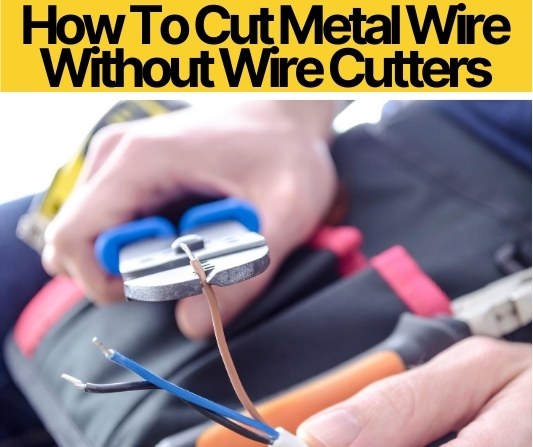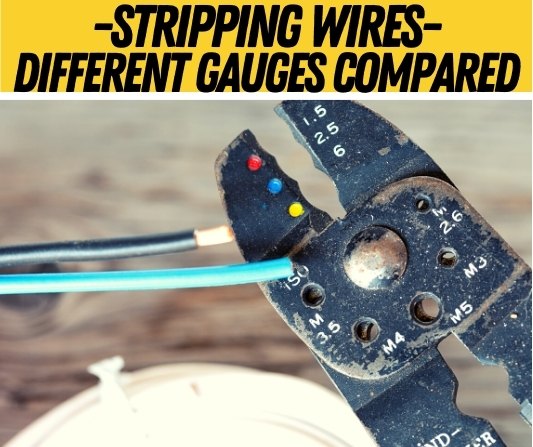 Realistically, wire cutters have been invented for a reason right?
Realistically, wire cutters have been invented for a reason right?
But, you might not have a pair, after all they are a kind of niche tool to have in the toolbox.
If you don’t own a pair but need to cut some form of wire, you have come to the right place.
It is possible to DIY cut your wire so let’s find out how!
How to cut metal wires without wire cutters
Realistically, wire cutters are the best tool for what they do. Pliers come a close second with the option to snip on them. But if you don’t have access to either of these tools, there are others ways around cutting the wire. Despite perhaps not giving the best results these methods should work to get your desired outcome.
There are numerous options of tools you can use to cut wires in your toolbox. Depending on the wire, depends on which method is the best. This article will give you a guide of which method to use on which wire!
What tool is used to cut wires?
Traditionally, the tool to cut wires is called a wire cutter. It acts in the same way scissors do but using a different blade style these tools are used to shred through wire with ease and precision, giving a neat finish and an easy grasp of the hand. Using wire cutters means you can get an exact and accurate cut on the piece of wire you are cutting and can be used on anything from barbed wire, to coat hangers to guitar strings.
See also : How to Strip Different Gauge Wires
Can you cut wires without wire cutters?
Despite, perhaps, not providing as clean a cut, as easy a time or potentially damaging the integrity of the wire, it is possible to cut wire without wire cutters. There are a number of other ways which can be used to cut wire effectively and mean you don’t need to invest in a pair of wire cutters or lose time going to the DIY store to purchase some.

What can I use instead of a wire cutter?
The most common alternative to wire cutters is pliers which provide the same pressure and sharp blade which makes it easy to cut wire. However, if you do not have pliers or traditional wire cutters available you can use other tools and methods to cut wire. Handheld bending of wires works, as does hacksaws, whilst numerous other tools in the shed ranging from tin snips, Stanley blades, angle grinders and reciprocating saws can all cut wire. Things like nail clippers, fire and scissors are options on certain wires too. All these methods do work, but the question is how effectively and how much work do they actually require.
Scissors
Scissors have commonly been used as a household alternative to wire cutters. Your household scissors will fairly easily cut through the outer plastic coating and then upon coming into contact with the wire will put up a fair bit of resistance. But with a little wriggle and a lot of grip you will eventually cut through the wire with household scissors. (FUN FACT: Using a set of scissors on a penknife/leatherman/folding-multi-tool allows for an even better and easier cut through thin wire). When cutting with scissors, you do face not only a considerable risk of some sort of electrical current running through you, but also damaging the wire from the inevitable hacked wire. This can lead to functional issues and even potentially dangerous future developments.
Regular pliers
If you are stuck for wire cutters in your tool box, the next best thing is pliers. Pliers actually do a very good job of cutting wires due to both their rubberized protection from current, easy grip, and their sharpness of blade which allows for precision and accuracy when cutting wires. Pliers can also be used across the board to cut a number of different wires around the house. Definitely, the next best thing and something that is fairly common within the garage.
Hacksaw
In theory it should work, right? Technically, it does cut through wire yes. Does it provide as good a cut? No. The reality is a hacksaw, particularly sharpened and with a higher TPI (teeth per inch) you can cut through a wire with relative ease. The very nature of a hacksaw does mean the cut is fairly rough and may compromise the function of the wire. All you need to do is simply hold the handle at 90 degrees to the wire and motion forward and back like you would normally saw with applied pressure, and you will cut through the wire.
Grinder
Yes you can! Infact, using a grinder is very useful for cutting wires that regular wire cutters or other tools you may want to use are too small for the bit of wire you need to cut. Particularly, angle grinders use a rotating blade which can cut through metal easily enough. Using goggles, stick the wire under the grinder and move it slowly into the blades path. It should create a cut easily and fairly accurately. The perfect tool to use for bigger wires you need to cut.
How to cut different wires without wire cutters
Okay, so we have established that not everyone has wire cutters sitting about handy and you can use other tools to cut wire. But wire comes in different forms, sizes and shapes depending on what it is you actually need cutting. Discussing this further, we have a look at what wire can be cut with what tool and we see if you can cut them all without wire cutters!
Electrical wire
Electrical wires are typically made up of common metals such as copper and aluminium coated in a plastic casing. This means when you are cutting through the wire you firstly have a hard yet malleable plastic coating to cut through before tackling the actual metal wire. This means you can have two approaches. You can either go straight for it in one swoop or else you can tackle the coating first then the metal wire. Either way cutting through a household electrical wire is pretty easy.
If you are going for the more rash straight cut, you can use anything; scissors, an axe, a hammer and chisel/screwdriver or a saw. If you are using the two step technique, one of the strongest tactics is to use either a lighter to burn through the plastic or the hook on a bottle opener which you can find on a utility knife which actually acts to scrap away the wire coating. Regardless of the tactic you use, it should be easy enough to cut through the wire, but ultimately you will be left with a less than desirable finish which could prove problematic if you intend to use the wire for future electrical endeavours.
Copper wire
Tools used to cut copper wire really do depend on what bit of copper wire you have and what size it is. Pliers tend to be the most effective for cutting copper wire at small sizes. However, if you lack access to pliers then a pocket knife/utility knife is your best bet for chomping through a small copper wire. However, as you move up the gauge in copper wire, this will not be effective. When you get to medium gauge wire – used in household wiring – you need to be looking at something with more heavy duty handles.
Here is where you should be turning more towards scissors or a grinder if you do not have a readily available set of pliers. If you need to cut large gauge copper wire, you need to consider if this wire is braided or twisted as this can cause some issues. If it is smooth, your best bet is to use bolt cutters to slice right through the wire. Alternatively, if the wire is braided a good option is to use a hacksaw as the bolt cutters may slide. It’s important when using a hacksaw to avoid fraying the wire as much as possible as this can ruin it, many advise to use a clamp when sawing.
Brake cable
You’re most likely to be faced with having to cut brake cables on your bike. This proves difficult without wire cutters and can prevent you from getting back on the saddle. Luckily there’s a number of ways to get past this. The most effective method, aside from using a specific bike wire cutting tool, is to use heat and bend the wire. Because they are malleable enough this is not actually too hard to do. This method actually has the added bonus of welding the frayed bit of wire to avoid any functional loss. Another useful option here is to use a dremel rotary tool which gives a good cut to the brake cable. Because they are thin enough wires this is easy to do but does leave a troublesome finish. Perhaps trying both these techniques together would provide the ultimate way of cutting a brake cable
Guitar strings
You can often be found in strange areas needing to change the strings on your guitar. Whether it be being on the road touring or in a forest camping, it’s essential to get the strings changed to let the good times roll. The best way to do this without wire cutters? Toenail clippers. Due to the thin nature of the strings, toenail clippers work a dream. Small and easy to use you just need to hold the string out stretched and snip away at the desired length. Simple!
Chicken wire
Chicken wire is notoriously annoying to work with. Its very nature means it catches on things and generally there’s just lots of it. This means using a single tool to cut through it can prove tedious. Despite it being thin and easy to cut using either wire cutters, pliers, scissors, dremels or any other method we have discussed previously you would be cutting for ages to get to the other side. So for cutting chicken wire your best bet is to look at going mechanical. An angle grinder is easily the best option. If fed into the grinder correctly and secured down making sure everything is stable (don’t want it snagging and becoming caught in the tool, snapping both the grinder and your face in the process) the angle grinder should whizz through it with ease. Much quicker and better than a single cut tool.
Curtain wire
Similar to electrical wires, curtain wires have a plastic coating with a malleable metal wire in the middle. Made to last, curtain wires are very durable and as such can be a bit of a pain to cut even with access to wire cutters or pliers. Your best bet for these wires is to use similar techniques dawned for electrical wires such as a hacksaw, a cleaver and meat board or else a hammer and screwdriver/chisel. Blunt force is probably going to be your best bet to get through these wires!
Wire hangers
Wire hangers are thin and easy to bend. It must be said the easiest way to cut wire hangers is to use the correct wire cutters or plier tools. But if these are unavailable the best option for cutting wire hangers? Your bare hands. Just keep bending that boy and it will end up snapping – Incredible Hulk style. The malleable nature of wire hangers means it shouldn’t take too long or too much strength to do this. Just keep at it!
Braces wire
Braces can often come loose and allow for a protruding wire in your mouth, particularly when you just get them. This can be sore and a pain in the butt (or mouth rather). After you’ve tried moving it back into place or covering it up with dental gum, you will want to end up just cutting that bit of wire off. The easiest way to do this is to use nail clippers. The wire is so thin it’s easy to chomp through with nail clippers quickly and effectively. You will want to sterilise the clipper before sticking them in your mouth – you don’t want a cheesy mouth after all. A very helpful tip is to place your finger on the wire you propose to cut, this stops the wire pinging off into your throat.
Really thick metal wire
Even with very thick metal wire, your wire cutters may not work the best. For thicker wire your best bet is to go automatic. If you do want to remain with a manual tool, bolt cutters will prove to be your best acquaintance. It would be better recommended, however, to whip out something like an angle grinder or another form of automated saw. The sheer power needed to cut through really thick metal wire means it’s sensible to just pass on the heavy work to our good buddy, electricity, to deal with.






